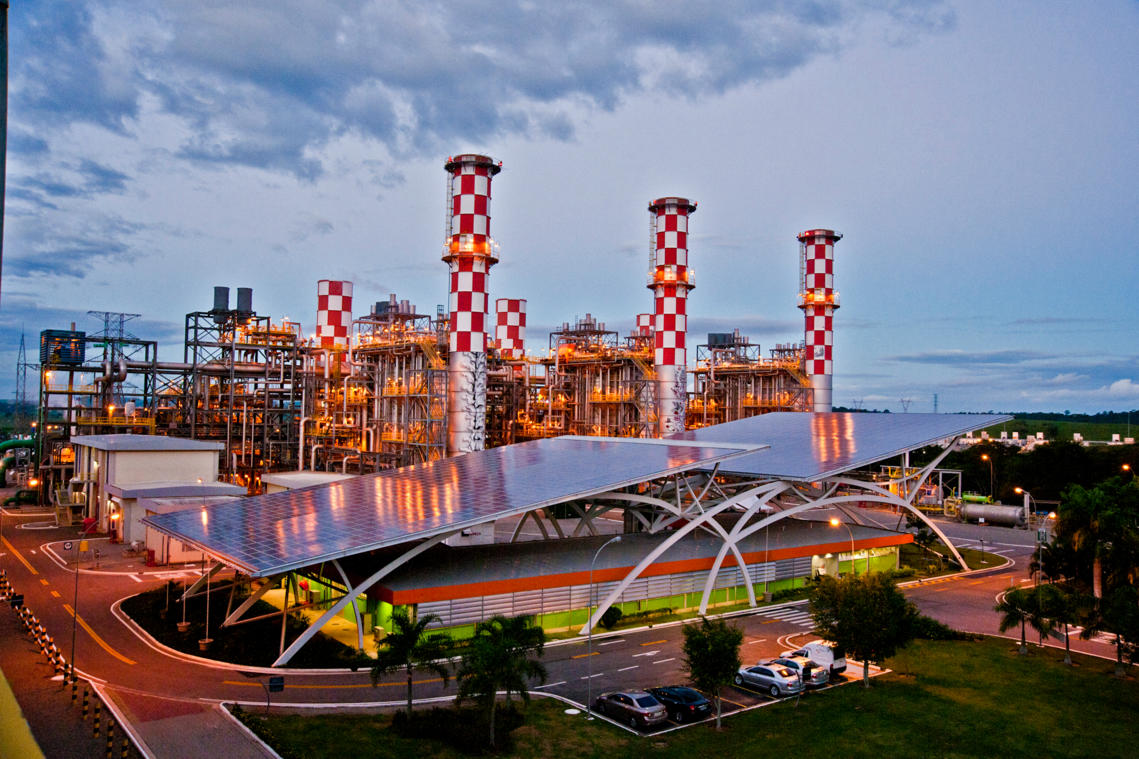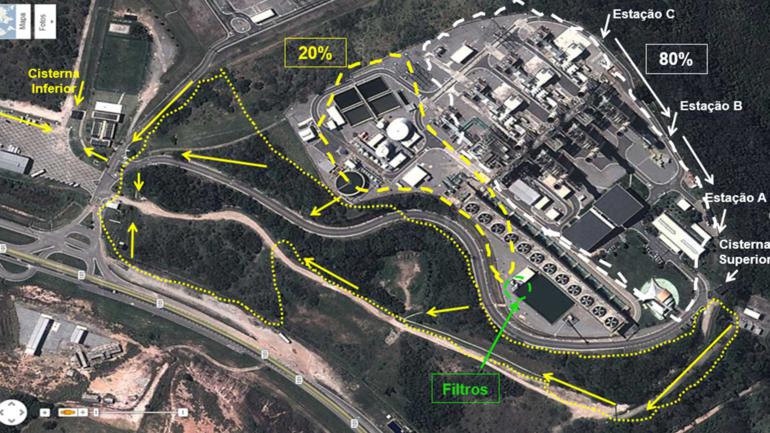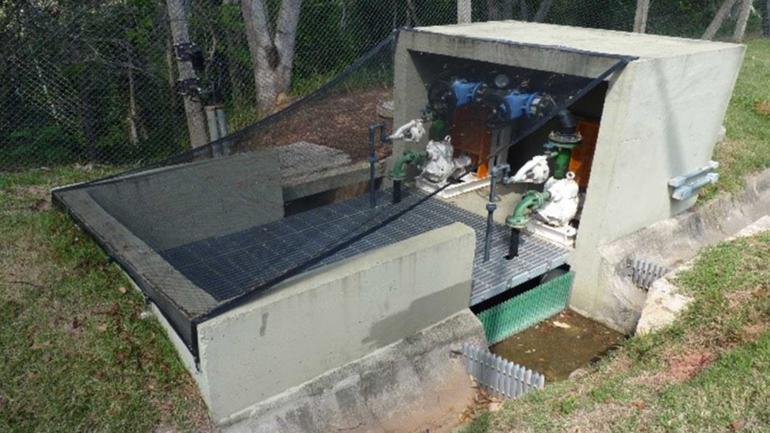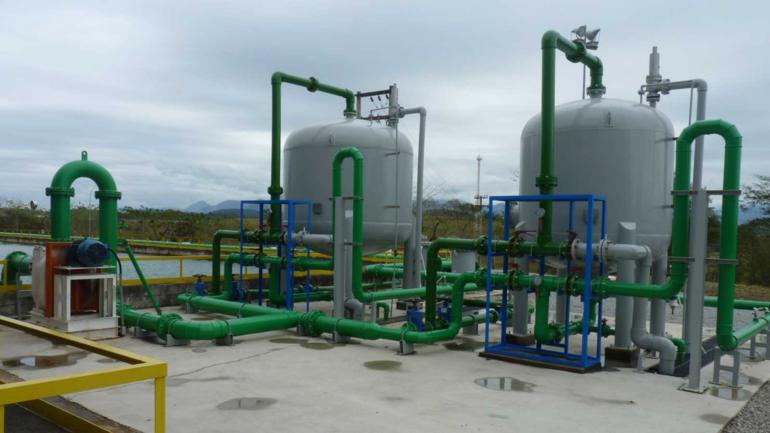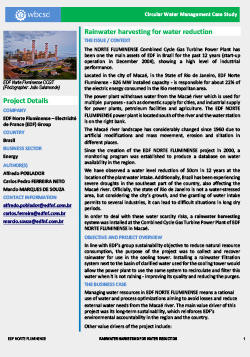The issue / context
The NORTE FLUMINENSE Combined Cycle Gas Turbine Power Plant has been one the main assets of EDF in Brazil for the past 12 years (start-up operation in December 2004), showing a high level of industrial performance.
Located in the city of Macaé, in the State of Rio de Janeiro, EDF Norte Fluminense - 826 MW installed capacity - is responsible for about 22% of the electric energy consumed in the Rio metropolitan area.
The power plant withdraws water from the Macaé river which is used for multiple purposes - such as domestic supply for cities, and industrial supply for power plants, petroleum facilities and agriculture. The EDF NORTE FLUMINENSE power plant is located south of the river and the water station is on the right bank.
The Macaé river landscape has considerably changed since 1960 due to artificial modifications and mass movement, erosion and siltation in different places. Since the creation of the EDF NORTE FLUMINENSE project in 2000, a monitoring program was established to produce a database on water availability in the region. We have observed a water level reduction of 50cm in 12 years at the location of the plant water intake. Additionally, Brazil has been experiencing severe droughts in the southeast part of the country, also affecting the Macaé river. Officially, the state of Rio de Janeiro is not a water-stressed area, but considering the city’s growth, and the granting of water intake permits to several industries, it can lead to difficult situations in long dry periods.
In order to deal with these water scarcity risks, a rainwater harvesting system was installed at the Combined Cycle Gas Turbine Power Plant of EDF NORTE FLUMINENSE in Macaé.
Objective and project overview
In line with EDF’s group sustainability objective to reduce natural resource consumption, the purpose of the project was to collect and recover rainwater for use in the cooling tower. Installing a rainwater filtration system next to the basin of clarified water used for the cooling tower would allow the power plant to use the same system to recirculate and filter this water when it is not raining - improving its quality and reducing the purges.
The business case
Managing water resources in EDF NORTE FLUMINENSE means a rational use of water and process optimizations aiming to avoid losses and reduce external water needs from the Macaé river. The main value driver of this project was its long-term sustainability, which reinforces EDF’s environmental accountability in the region and the country.
Other value drivers of the project include:
- Reduction in water consumption due to collected rainwater
- Reduction in water consumption due to avoided purges (reduced cooling tower make-up)
- Reduction (economical savings) of chemical products needed for clarification.
- Energy savings on rainy days because the water intake pump does not function on those days.
The project was commissioned in March 2012 and estimated investment in the project was 2.5 MBRL (the equivalent of around USD 1.47M). The aggregated O&M OPEX (maintenance for pumps, filters, etc. and human resources) is very low and easily absorbed by the established resources of the power plant organization.
Decision making process
The project originated among employees at a brainstorming session, a regular practice at EDF NORTE FLUMINENSE – where employees look for new and innovative ideas to increase performance in all domains. The decision-making process involved technical and HSE departments with the full support of management and the Board of Directors since the inception of the project.
Project details & finances
The project was divided into different stages, including elaborating a study on the rainfall precipitation in the region, defining the adequate contribution area for rainwater harvesting (Figure 1), calculating the amount of water that could be captured and eventually evaluating the viability of the project. Throughout that process, we relied on the consulting services of a civil engineer.
Once the feasibility of the project had been assessed, the challenge was to figure out how to use a system that worked on sunny days too, so it could minimize problems during the dry period. The solution was to install the rainwater filtration system (Figure 3) beside the basin of clarified water used as make-up of the cooling tower in order to recirculate and filter the make-up water when it is not raining, which allows to improve the quality of make-up water, reducing the purges and as a result, the water consumption.
The results of the studies showed that an area of around 37,000m² can, on rainy days, recover up to 225m³/h of water, which represents 30% of the company’s process water needs. In addition, by using the rainwater filters to recirculate the cooling tower make-up water, this system allows an annual saving of around 2% of the water taken from the Macaé River (around 100,000 to 130,000m³).
Predicted |
Actual |
|
Total Investment |
2.5MBRL |
2.2MBRL (around USD 1.29) |
Annual savings (USD) |
N/A |
USD 15,000 - 20,000 |
Annual water savings |
N/A |
100,000 - 130,000m³ |
Annual energy savings (if tracked) |
N/A |
N/A |
- By reducing purges and using the rainwater collected, savings in chemical products are around USD 15 to USD 20K (costs of chemicals for water treatment are around $0,16 USD/m³ of water)
- Turbidity of the basin reduced on average from 4.0 to 1.0 NTU (Nephelometric Turbidity Units)
- Turbidity of the cooling tower water decreased from 20.0 to 5.0 NTU, which contributes to a decrease in fouling in the Steam Turbine condenser, resulting in improved efficiency of the plant and a reduced Heat Rate which leads to a lower fuel consumption for the same power output.
- Reduction of purges by 12 m³/h due to the low turbidity of the cooling tower water
- On rainy days the collection of 225 m³/h equals 30% of the maximum consumption of the plant
- Estimated energy savings on rainy days (by turning off 1 raw water intake pump):
- 1 pump raw water capture - 580 m³/h - consumes 124 kWh
- 11 pumps - with a total capacity of 225 m³/h - consume 93 kWh
- Saving of 29kWh
Lessons learned
This project demonstrated that actions towards improving sustainability and environmental accountability can bring a financial return and drive optimization of the use of resources while raising environmental awareness and improving processes.
Some key lessons learned have been:
- The project required strong efforts towards building the system without affecting normal operations in the plant.
- A detailed feasibility study is highly advisable for any project of the same nature.
- The project received a “Mention of Honor” in the Awards “Prêmio TOP ENERGIA” held by Petrobras. This increased visibility of the project led to some companies requesting additional information to evaluate the possibility of developing similar projects in their plants. By collaborating with other companies, EDF NORTE FLUMINENSE contributes to the dissemination of good practice and the sustainability of the region.
- It is important to account for data records of the process to aid in preliminary feasibility assesments. For instance, data from the drainage system of the higher part of the site was not available and had to be calculated.
- It is always a challenge to bring in a new project into regular activities and operational goals. Successful implementation was highly dependent on full support from the whole team and this was made possible thanks to the company’s appropriate management communication and a sustainable corporate culture.
This case study forms part of the WBCSD Business Guide to Circular Water Management (2017), available for download here.
Download case study
Project detailsCompany: EDF Norte Fluminense – Electricité de France (EDF) Group Country: Brazil Business sector: Energy Author(s): Alfredo POBLADOR, Carlos Pedro FERREIRA NETO, Marcio MARQUES DE SOUZA Contact information: alfredo.poblador@edfnf.com.br, carlos.ferreira@edfnf.com.br, marcio.souza@edfnf.com.br |

